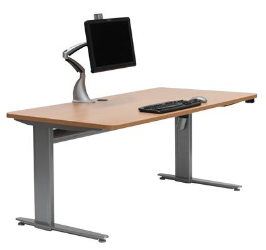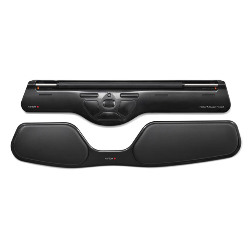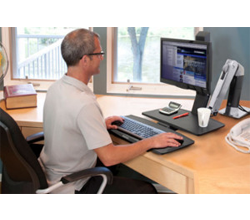The War On Sitting
You’ve already heard that sitting is the new smoking. Now, scientists reveal exactly how it hurts the body—and novel ways to undo the damage (without clocking hours at the gym). You might want to stand up for this.
We like to think we’re a stand-up species. After all, that’s what drove our evolutionary march away from many of our four-legged ancestors. But everywhere we go are invitations to sit down. Hop into your car and what’s there? If you’re lucky, a plush bucket seat designed with just the right tilt for your back. On the subway to work? A less comfortable seat, to be sure, but you’ll grab one if you can. Once at work, an office chair. At home, your favorite fauteuil. But all that hospitality, all those opportunities to give your feet a break, are doing untold things to the rest of your body.
From standing desks and fitness trackers to groundbreaking pilot experiments in high schools in several cities, the movement to sit less and stand more is gaining momentum. Which is a good thing, because new evidence suggests that the more than eight hours the average American spends sitting every day could be exacting a serious—and previously misunderstood—toll.
Studies have long connected sedentary behavior to poor health, including heart disease, diabetes, obesity and hypertension. But doctors thought those problems could be traced to the fact that people who sat more were probably just not working out very much. The public health messages were in step with that thinking. “Let’s Move!” became a national mantra.
But while exercise is critical, it alone can’t make up for the ills of idleness. New research shows there’s a big difference between exercising too little and sitting too much. That’s because a standing body uses energy altogether differently from a sedentary body—and also from an exercising one. We burn calories at a different rate, store them in different ways, and our brains function differently, too. While data is still emerging, one experiment with high school kids found that standing in class instead of sitting improved their test scores by 20%.
All of which has doctors and health experts calling for a paradigm shift. “In the same way that standing up is an oddity now, sitting down should be,” says Dr. James Levine, director of the Mayo Clinic-Arizona State University Obesity Solutions Initiative and probably best known as the inventor of the first treadmill desk. “My argument is that whatever building it is—a movie theater, airport, arts complex—a fundamental part of our thinking has become that people who enter that space will need to be seated.” And that’s what got us into all this trouble in the first place.
This Is Your Body On Sitting
It’s not entirely our fault. As we moved from an active, agricultural lifestyle to one of offices and automated transport, every aspect of our day, from our meals to our jobs and our entertainment, have been adapted with one priority in mind: our comfort. Where our ancestors spent the large bulk of their waking hours on the go, modern life entails sitting for as much as half the day (and that’s not counting sleeping).
The first studies to connect sedentary behavior to poor health emerged in recent decades when scientists started to confirm, in a reproducible way, the effect that extra pounds can have on the body. In these large analyses of men and women of nearly every age, the message was clear: People who spent more hours of the day sitting were more likely to develop a host of health problems.
A closer look at that data showed that swapping an hour on the couch for an hour playing catch wouldn’t cut it. A recent review of 43 studies analyzing daily activity and cancer rates found that people who reported sitting for more hours of the day had a 24% greater risk of developing colon cancer, a 32% higher risk of endometrial cancer and a 21% higher risk of lung cancer—regardless of how much they exercised. In another study involving a group of men and women who reported exercising the same amount, each additional hour they spent sitting was linked to a drop in their fitness levels. In other words, sitting was chipping away at some of the benefits of exercise.
That’s an important realization. The human body consumes energy in three main ways: every cell needs energy to go about its daily business, whether it’s a muscle cell that contracts and flexes or a liver cell that produces enzymes; we also need to break down the food that we eat; finally, we need energy to move, whether we’re pulling on a shirt or riding a bike. That latter energy—let’s call it activity energy—is further divided into the sweat-inducing kind that you use on the treadmill or in yoga and another kind, which scientists have cleverly called NEAT: non-exercise activity thermogenesis. This includes nearly everything you do requiring movement: folding the laundry, walking up a flight of stairs, running to catch a train, even fidgeting.
The human body is designed to move, and a moving body is a needy body, siphoning off calories to make sure every cell is doing what it’s supposed to do. But even when we’re not exercising, we’re moving and using energy. That’s why NEAT matters. A body that’s sitting isn’t expending energy, so the signals that normally result in you moving—and which, in turn, burn calories—start to check out, molecularly bored with not being called into duty. Meanwhile, the processes that build up fat get busier. When that happens, it gets harder and harder to get off the chair.
The other signals that keep us rooted on our rears may originate in the brain. In animal studies, obese rats seemed to have a switch that prevented them from burning NEAT calories efficiently. The reason why isn’t clear yet, but researchers are studying the brain signals that govern what makes us more likely to move—or not move—to answer it.
That could help explain, at least in part, why too much sitting seems to be so bad for the human body. People who sit at their desks most of the time, for example, only polish off 300 NEAT calories a day compared to, say, a coffee shop barista who spends most of his or her shift standing—and burning up to 1,300 extra calories daily.
There’s also intriguing evidence that sitting less may short-circuit some bodily processes that lead to diabetes. When we eat meals, our bodies experience a surge in blood sugar that peaks about an hour after we eat. If we’re sedentary and relatively immobile, our muscles and cells aren’t soaking up that glucose to fuel its daily activities. So all that extra sugar gets turned into fat. If we take a walk after lunch, however, some of that sugar is burned off in order to keep us on our feet and propel us forward. The less sugar that’s left after that activity, the less that gets turned into fat and contributes to obesity and eventually diabetes.
Becoming a body in motion
Even if you’re wired in some ways to sit, can you become a stand-up person? Absolutely, says Levine. Just as sedentary behavior can change the brain and body to prefer sitting, getting up and becoming more active will prompt you to want to stay in motion. And that can have benefits on productivity and possibly creativity as well, although while the data on the harms of sitting are pretty well documented, the productivity benefits are still anecdotal. But researchers, including Levine, are working on that.
In Rochester, Minn., for example, Levine conducted an experiment with the help of Apple, which donated computers and other supplies, on a School of the Future concept that rethought the classroom model of kids sitting at attention. Instead, the kids stood and moved. Levine and his team strapped sensors to the legs and backs of students to measure their NEAT levels. The students had mobile stations that held their laptops, which they could move around the classroom. Benches let the kids sit when the wanted to, but the default was clearly toward standing and moving.
After two months, the teachers reported that the students took fewer bathroom breaks, engaged in less frivolous movement, and related better to each other. Parents also noticed a difference. They said, almost unbelievable, that their children came home more eager to do homework and less stressed after their day. And what did the NEAT sensors show? The children doubled their activity level compared to when they were in a traditional classroom. Finally, the pioneering students scored up to 20% higher on state standardized tests than they had previously.
Even if you don’t have the help of Apple or a forward-thinking boss to transform your workplace, there are ways to make yourself get up. For the more ambitious, there’s changing your work station to a standing one (see how one TIME staffer did the same by reading this story). But even simply fielding phone calls on your feet is a good way to start, or pacing while you talk. You could also keep a small glass of water on your desk so you’re inclined to get up more frequently to refill it, taking walks around the office or your home while you’re at it. For the more ambitious, says Levine, urge your colleagues to try standing meetings.
“By simply changing your work style, from a chair-based work style to a [standing] one, you can burn 500 to 1,000 extra calories a day,” he says. And it’s not just the calories that count. One study found that regardless of how many hours a group of men spent sitting daily (in their cars or watching TV), those with higher fitness levels – which is, of course, a product of regular exercise – did not show an increased risk of metabolic syndrome, the suite of conditions that include obesity and high cholesterol and are associated with a higher risk of heart disease.
How do you turn your sitting day into a standing one? In 2000, Levine addressed the office chair culture head on when he and a colleague raided the Mayo Clinic basement, where old and broken furniture was stored, and with some duct tape and a saw, put together a patient table that could be adjusted for height with a Sears treadmill to make the first treadmill desk. After some number crunching, he figured out that the optimal speed for writing and walking was about 1 mph, so he adjusted the speed of his contraption to keep his fingers and feet moving without falling off the device.
Now, there are far fancier versions of the treadmill desk that allow you to switch between desk and full treadmill mode (minus the duct tape). And they’re becoming less of an oddity.
“What we need to do is change the default,” Levine says. “I want us to have to find excuses to be sitting down.” Imagine that. Maybe standing really could be the new sitting.
Article by Alice Park - Time Magazine
|
|||||||||
|





